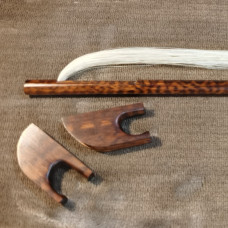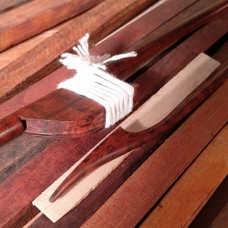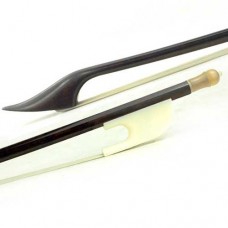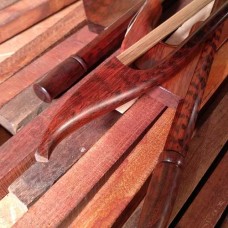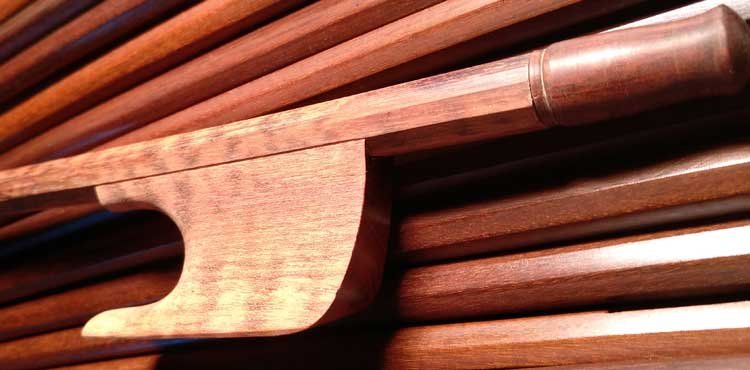
The violin family would not sound as we know it without the bow. Yet the bow has changed as dramatically as the instruments themselves. Between roughly 1600 and 1780, bow makers experimented with virtually every aspect of design: the frog, the stick profile, the head, the camber, and the materials used. Those design choices directly shaped the sound world of Monteverdi, Corelli, Bach, Handel, C.P.E. Bach, Haydn, and Mozart.
Today, performers and instrument makers alike are rediscovering the artistry of historical bows. To play Baroque music with authentic colours and articulation you must look beyond the modern Tourte-style bow and return to the tools makers and players used in earlier centuries.
This guide traces the evolution of Baroque bows from the early clip-in frog designs through high-Baroque models to the transitional bows that paved the way to the Classical era. It is not the story of a single “Baroque bow”—it is the story of a wide family of solutions responding to the changing aesthetics of music.
Early Baroque Bows (c. 1600–1700)
Construction features
- Frog: The early bow’s frog is typically a simple wooden block that clips into a mortise at the stick’s heel. It was secured by wedges or friction—not by an adjustable screw—so hair tension could not be finely adjusted during performance.
- Stick shape: Many early bows are nearly straight or show a gentle convex camber (bending outward away from the hair). This produces a springy, speech-like response.
- Length: Surviving violin bows from this period commonly measure in the range of approximately 55–62 cm, shorter than later bows.
- Weight: Violin bows often fall roughly between 40–48 g, though examples vary considerably.
- Materials: Snakewood (letterwood) was widely used for high-quality bows because of its density and visual figure. Other heavy tropical hardwoods were also employed depending on region and availability.
Musical use
These bows are well suited to early Baroque repertoire: Monteverdi’s late works, Marini, Biber’s dance writings, and early Corelli sonatas. The natural decay and articulation of the clip-in bow matches the rhetorical, speech-like phrasing and dance-driven pulse of the era. Notes often fall away like syllables rather than remaining sustained for very long.
Player’s experience
Musicians who use clip-in bows today report the following practical characteristics:
- Excellent agility for dance rhythms and short, articulated strokes.
- Sustained legato requires active bow speed and intention from the player.
- Hair tension is less adjustable than on screw-frog bows; players must manage this through technique and occasional off-stage adjustments.
- Because the frog is wedged rather than screwed, the frog can feel less mechanically secure than modern frogs—this affects feel, not necessarily tonal quality.
High Baroque Bows (c. 1700–1750)
Construction features
- Camber: By the early 18th century some makers introduced a gentle inward bend (a slight concave camber). This was not universal, but it became more common as makers sought smoother legato and more reliable hair tension.
- Length: Violin bows typically lengthened toward approximately 62–65 cm, allowing greater reach and more room for expressive shaping of phrases.
- Weight: Weights for violin bows in this period often fall into an approximate range of 45–52 g, with local and maker variation.
- Frog: Clip-in frogs remained common; some instruments show more refined frog shaping and fastening systems (slides and wedges) that improved stability.
Musical use
This era coincides with J. S. Bach, Handel, and much of Vivaldi’s output. The longer stick and emerging concave profile help balance the need for crisp articulation and the growing demand for sustained melodic lines and contrapuntal clarity. These bows are versatile: they articulate dances well but also support the more sustained phrasing required by concertos, arias, and large-scale contrapuntal works.
Player’s experience
- Clear articulation combined with improved capacity for longer, singing lines.
- Better stability on lower strings, useful for continuo playing and orchestral textures.
- Greater variety of expressive options—players can move between articulated and legato styles within the period idiom.
See High Baroque bows made for Bach, Handel, and Vivaldi.
Transitional Bows (c. 1750–1780)
Construction features
- Camber: The stick becomes increasingly concave in profile, though the deep Tourte camber characteristic of the 19th century appears later. Transitional bows typically show a moderate inward curve.
- Length: Violin bows of this phase usually range near 65–68 cm, approaching modern dimensions.
- Weight: Violin bows often fall roughly between 48–55 g, depending on stick cross-section and wood.
- Frog: Early screw mechanisms appear during this period (the innovations often associated with François Tourte are late in this era). For several decades screw frogs coexisted with clip-in and slide-in frogs.
Musical use
Transitional bows answer the expressive needs of late Baroque and early Classical music—works by late J. S. Bach, C. P. E. Bach, early Haydn, and early Mozart. These bows better support sustained legato, an expanded dynamic range, and wider expressive shading.
Player’s experience
- Balance often shifts slightly closer to the middle of the stick, which aids long lines and sustained phrases.
- They produce a smoother, more singing tone than early clip-in bows while remaining generally lighter-feeling than later Romantic bows.
- Transitional bows are versatile: suitable for both late Baroque repertoire and the growing demands of Classical-era style.
Bows and Music: An Evolving Relationship
One of the key principles of historically informed performance is that instrument design and musical style influence one another. Bow design did not force composers to write in a particular way; rather, the available bow types shaped the practical possibilities performers relied upon. In short:
- Early Baroque (clip-in) — Ideal for short, dance-like phrases and rhetorical articulation.
- High Baroque — Versatile for counterpoint and expressive arias; a balance between clarity and sustain.
- Transitional — Supports long legato lines, dynamic contrast, and the expressive aims of early Classical style.
Why These Bows Matter Today
For musicians and collectors, Baroque bows are more than historical curiosities. They offer:
- Authenticity: A way to experience historical repertoire in a manner closer to period sound and technique.
- Interpretive inspiration: Different bows encourage different phrasing, articulation, and rhythmic nuance.
- Craftsmanship: Historical bows reveal the solutions makers developed with limited tools and exceptional skill.
Choosing Your Bow
Below are practical pairings based on repertoire preference (these are general guidelines rather than strict rules):
- Corelli, Biber, early Vivaldi — a clip-in frog bow for crisp articulation and lively dance rhythms.
- Bach (concertos, cantatas), Handel — a high-Baroque bow that balances clarity with the capacity for sustained lines.
- Late Bach, C. P. E. Bach, early Haydn & Mozart — a transitional bow that supports legato and dynamic shading.
When choosing, consider also:
- Your instrument and its setup (gut vs. modern strings).
- Your typical repertoire and whether you need a single versatile bow or several period-appropriate bows.
- Your playing technique—some players prefer slightly lighter sticks while others want a bit more mass under the hand.
What Else
There is no single “Baroque bow.” Instead there is a living tradition of designs that evolved as musicians’ expressive needs changed. From the lightweight clip-in frogs of the early 1600s to the longer, more concave transitional sticks of the late 1700s, each model offers distinct capabilities and challenges.
For players today, using these bows is a way to rediscover the phrasing, articulation, and tone colours that shaped centuries of Western repertoire. For makers and collectors, historical bows remain a compelling demonstration of how materials, technique, and musical thought come together in a single crafted object.
Explore our collection of handcrafted Baroque bows — each made to historical dimensions and tailored for modern performers interested in historically informed performance.

